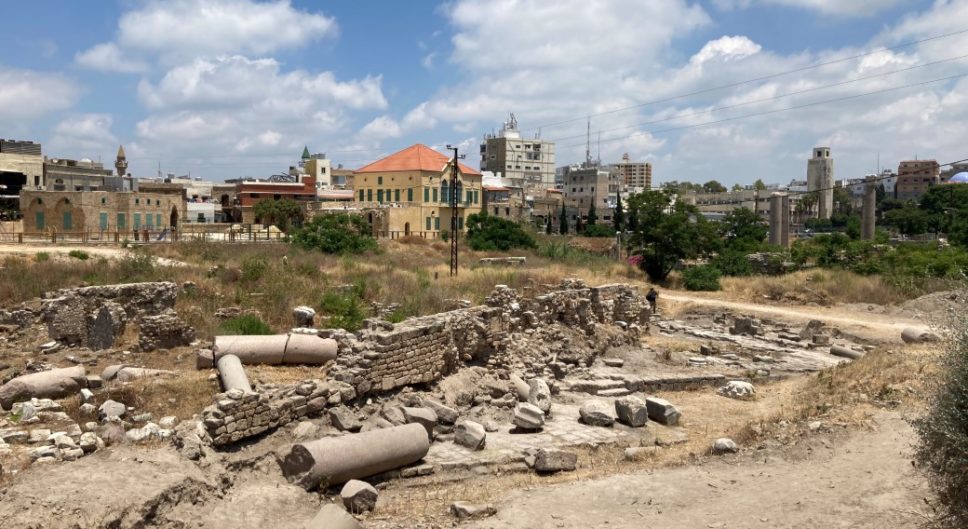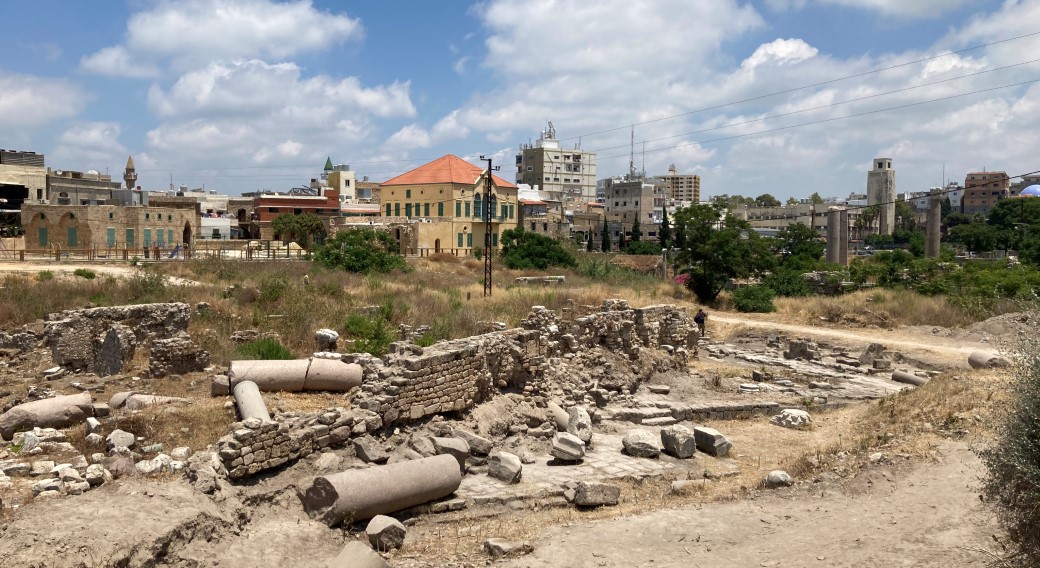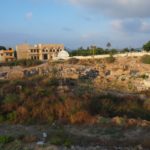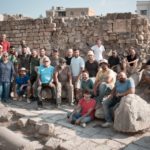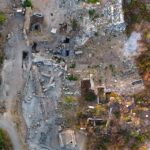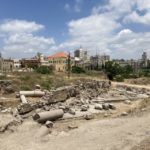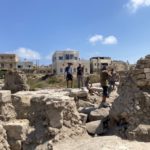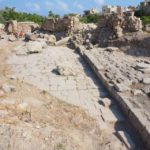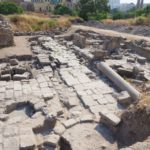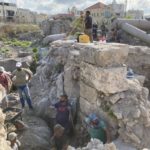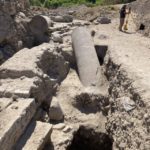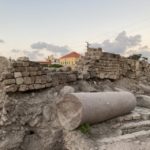Tyre
-
Project name:
Lebanese-Spanish-Polish Archaeological Expedition in Tyre (Lebanon)
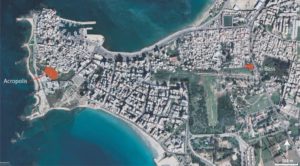
-
Type of site:
– al-Bass: Iron Age cemetery
– Acropolis: multi-period urban siteLocation:
Lebanon
Mediterranean coast
The modern city of ṢūrDating:
– from the 3rd millennium BCE to this day
Most interesting finds:
In al-Bass:
– cremation tombs belonging to the citizens of the Iron Age city of Tyre
In the Acropolis:
– urban remains from the time of the city’s foundation in the 3rd millennium BCE to the 20th century CE
– Early and Late Bronze Age and Iron Age buildings
– a religious complex with two temples, a dromos and an altar installation that dates from the Roman period
– remains of other Roman as well as Byzantine, Crusader and Ottoman buildings and installations, such as terraces
History of research:
The project started in 1997 as a Spanish-Lebanese cooperation. The Polish Centre of Mediterranean Archaeology of the University of Warsaw joined the project in 2020.
Type of research:
Excavations
Directors:
(1997–2002) María Eugenia Aubet
(2002–2014) María Eugenia Aubet (co-directors: Francisco J. Núñez and Laura Trellisó Carreño)
(2014–2020) María Eugenia Aubet and Ali Badawi (co-directors: Francisco J. Núñez and Laura Trellisó Carreño)
(2021–) María Eugenia Aubet, Ali Badawi and Francisco J. Núñez (co-director: Laura Trellisó Carreño)
Co-operating institutions:
– General Directorate of Antiquities of Lebanon
– Pompeu Fabra University of Barcelona
– Spanish Ministry of Science and Culture
– Pallarq Foundation
– Polish Centre of Mediterranean Archaeology, University of Warsaw
Additional information:
In the 1960s and ‘70s emir Maurice Chehab, the General Director of Antiquities, undertook extensive excavations in Tyre focused on two areas: the base of the tombolo (the strip of land joining the ancient island to the mainland), which gave rise to the archaeological park of al-Bass, and the southern part of the ancient island where the Basilicas Archaeological Park and the sector under investigation in the current project are located. Chehab’s investigations reached levels dating from the Roman and Byzantine times. In the early 1970s, Patricia M. Bikai’s excavations provided a continuous stratigraphic sequence beginning with the Early Bronze Age and reaching the 7th century BCE. The outbreak of the civil war in 1975 abruptly ended all archaeological works in Tyre. Only in 1997 could they be systematically resumed.
At first, excavations took place in the cemetery of al-Bass. Work on that site continued until 2014 when the second phase of the project started and investigations moved to the ancient island of Tyre, close to the Crusader’s Cathedral.
In 2022 two projects started:
– “A holistic approach to ceramic production in Tyre from the Bronze Age to Late Antiquity. A diachronic and technological definition of a traditional economic activity”, project received NCN (UMO-2021-/43B/HS3/00354), Principal Investigator: Dr. Francisco J. Núñez.
– “Commercial contacts between the central Levant and Cyprus in the Iron Age. The case of Tyre“, project received funding from Center for Research on Ancient Civilizations of the University of Warsaw (CRAC) in The Small Grant programme, Principal Investigator: Dr. Francisco J. Núñez.
In 2023 two projects started:
-“The paleoenvironmental evolution of a Levantine coastal city in the Bronze Age. The case of Tyre (Lebanon)“, project received funding from Honor Frost Foundation, Principal Investigator: Dr. Francisco J. Núñez.
– “An interdisciplinary study of scent substances from Phoenicia during the Hellenistic and early Roman periods. Identification of the organic contents of unguentaria and amphoriskoi produced in Tyre“, project received funding from University of Warsaw in New Ideas 3B in Priority Research Area IV programme Principal Investigator: Dr. Urszula Wicenciak-Núñez.
Description of the site and research:
The city of Tyre was one of the most significant economic centers of the Mediterranean world throughout much of Antiquity, hence its inscription on the UNESCO World Heritage list in 1984. It was for the most part located on an offshore island (originally, on two islands that were conjoined in the 10th century BCE) that could have extended up to 3 km away from the coastline. The island was eventually joined to the shore by a causeway built by Alexander the Great and is now an integral part of the mainland.
The city was continuously occupied since at least the 3rd millennium BCE. This constant urban growth make it both a fascinating object of study and a difficult one. The superimposed architectural vestiges along with natural catastrophes, the rise of the sea level, and modern public works efficiently obscured the character of the Bronze and Iron Age occupation which is very poorly known despite the importance of Tyre at that time.
Tyre’s wealth and prestige stemmed from the city’s industrial and commercial activities. Five elements defined its urban status in Antiquity: the ramparts, its two harbors, the market place, the royal palace, and the temple of Melkart, the main god of the city. However, most of these elements are known only from written sources, while the available archaeological evidence is very limited. In point of fact, our knowledge is almost completely restricted to glimpses of the Roman and Byzantine remains that are now concentrated in two archaeological parks: at the sites of al-Bass and the Basilicas.
The objective of the current project is twofold. Firstly, to shed light on the nature, history, and evolution of urban planning in the ancient island. Secondly, to establish the guidelines for the creation of a new archaeological park, which will contribute to enhancing the tourist and cultural attraction of the city.
The research area lies west of the Basilicas (City Site) Archaeological Park and the remains of the famous Crusader’s cathedral. It seems to have been one of the highest (if not the highest) points of the ancient island. The area was partly excavated in the past (see above) but very little information on the results of that work is currently available as most of it perished during the civil war. These excavations left behind a number of scattered structures of all periods in need of interpretation, and some deep soundings that became a relevant source of stratigraphic information. One of them evidenced Early Bronze Age levels sitting on bedrock, followed by a hiatus during the Middle Bronze Age, and a re-occupation of the area from the Late Bronze Age until the Crusader’s period. With the arrival of the Mameluke period this part of the island was abandoned and occupation shifted to the north.
The structural remains point to a sacral character of this prominent area. Two parallel monumental buildings with the same east-west orientation were discovered there. In Roman times, a street led to this architectural ensemble from a lower part of the town. The buildings had a quadrangular plan and their facades were equipped with two columns of Egyptian pink granite. In their vicinity, portions of massive Egyptian gorges and votive inscriptions in Phoenician and Greek scripts were discovered. The cult-related nature of this area is particularly evident from the Roman period until its destruction in early Byzantine times. Regarding the Iron Age, this character is not fully confirmed at the present state of research. However, structures of this date recognized so far seem to be standing on a platform which is a typical feature of sacral buildings.
Analysis of the nature and evolution of this sacral area of Tyre throughout Antiquity is the immediate objective of the next phase of the project. In addition, excavating new areas to the north and west, where domestic structures have been identified, will allow to trace the integration of this area within the city.
Results of research:
Season by season (team members and information on fieldwork):
Associated news:
2021-09 PCMA UW joins excavations in Tyre (Lebanon)
2020-06 Fundación Palarq Masterclass 36: Tiro Monumental (YouTube video)
Aubet, M. E., Badawi, A., Núñez, F. J., (2019). Excavaciones en la acrópolis de Tiro (2014–2106), Informes y Trabajos 17, 154–163.
Núñez Calvo, F. J., (2017). The Tyrian cemetery of al-Bass and the role of ceramics in the Phoenician funerary ritual, Levant 49, Issue 2, 174–191.
Aubet, M. E., Núñez, F., Trellisó, L., (2016). Excavations in Tyre 1997–2015. Results and perspectives, Berytus 56, 3–14.
Núñez Calvo, F. J., (2015). The al-Bass funerary ceramic set’. In Anne-Marie Feiche (ed.), Cult and Ritual on the Levantine coast and its impact on the Eastern Mediterranean Realm (=Bulletin d’Archéologie et d’Architecture Libanaises, Hors Serie X) (pp. 15–33). Beirut.
Aubet, M. E., Núñez, F. J., Trellisó, L. (eds.), (2014). The Phoenician Cemetery of Tyre – Al Bass II. Excavations 2002–2005 (Bulletin d’Archéologie et d’Architecture Libanaises, Hors Serie Nr IX). Beirut.
Núñez Calvo, F. J., (2014). The ceramic repertoire of the Iron Age. In Aubet, M. E., Núñez, F. J., Trellisó. L. (eds.), The Phoenician Cemetery of Tyre – Al Bass II. Excavations 2002–2005 (=Bulletin d’Archéologie et d’Architecture Libanaises, Hors Serie Nr IX) (pp. 261–372). Beirut.
Núñez Calvo, F. J., (2013). De Tiro a Almuñécar. Conexiones metropolitanas de un contexto colonial fenicio, Madrider Mitteilungen 54, 27–88.
Núñez Calvo, F. J., (2013). Tyrian potters and their products: standardization and variation in the pottery of the al-Bass cemetery. In A. Kotsonas (ed.), Understanding standardization and variation in Mediterranean ceramics: mid 2nd to late 1st millennium BC (=BABesch Supplementa Series 25) (pp. 61–86). Leiden.
Núñez Calvo, F. J., (2011). Tyre – al Bass: potters and cemeteries. In Sagona, C. (ed.), Ceramics of the Phoenician – Punic world: collected essays (=Ancient Near Eastern Studies, Supplement 36) (pp. 277–296). Leuven.
Aubet, M. E., Núñez, F. J., (2008). Cypriote imports from the Phoenician cemetery of Tyre, al-Bass. In C. Doumet-Serhal (ed): Networking patterns of the Bronze and Iron Age Levant. The Lebanon and its Mediterranean connections, Archaeology and History in the Lebanon, Special Edition (pp. 71–104). Beirut.
Núñez Calvo, F. J., (2008). Tyre – al Bass ’97: the pottery evidence. In A. Spanò Giammellaro (ed.), Atti del V Congresso Internazionale di Studi Fenici e Punici. Vol. I. (pp. 93–106). Palermo.
Núñez Calvo, F. J., (2004). Preliminary report on ceramics from the Phoenician necropolis of Tyre – al Bass, 1997 campaign. In Aubet, M. E. (ed.), The Phoenician cemetery of Tyre – Al Bass, excavations 1997–1999 (=Bulletin d’Archéologie et d’Architecture Libanaises, Hors-Série 1) (pp. 281–373). Beirut.
Aubet, M. E., Núñez, F. J., Trellisó, L., (2004). La necrópolis fenicia de Tiro – al Bass en el contexto funerario fenicio oriental. In J. Fernández Jurado, C. García Sanz, P. Rufete Tomico (eds.): Actas del III Congreso Español de Antiguo Oriente Próximo. Huelva, del 30 de Septiembre al 3 de Ocutbre de 2003 (=Huelva Arqueológica 20) (pp. 41–62). Huelva.
Gallery:
-
View of the site from the north / widok stanowiska od północy (fot. Francisco J. Núñez)
-
Project team and staff in the 2021 season / Członkowie projektu i pracownicy w sezonie 2021 (fot. Maksym Mackiewicz)
-
Top view of the site at the end of the 2021 season / Widok z góry pod koniec sezonu 2021 (fot. M. Mackiewicz)
-
View of the excavated area from the southwest / Widok stanowiska z południowego wschodu (fot. U. Wicenciak-Núñez)
-
Clearing and documenting the Roman-period dromos / Oczyszczanie i dokumentacja rzymskiego dromosu (fot. U. Wicenciak-Núñez)
-
The Roman dromos with a porticoed sidewalk, and the Ottoman wall viewed from the east / Rzymski dromos, portyk oraz mur ottomański – widok od wschodu (fot. Francisco J. Núñez)
-
The eastern sector of the site; Roman streets and shrine on the right / Wschodni sektor stanowiska. Po prawej rzymskie ulice i kapliczka (fot. Francisco J. Núñez)
-
Work in the location of the Roman temple’s facade, with the foundation of a column in the foreground / Prace przy fasadzie świątyni rzymskiej; na pierwszym planie fundament kolumny (fot. U. Wicenciak-Núñez)
-
Structures from different historical periods of the site’s occupation: a retaining wall, a fallen column from the Roman times and an Ottoman-period wall / konstrukcje z różnych okresów zasiedlenia stanowiska: mur oporowy, powalona rzymska kolumna i ottomański mur (fot. U. Wicenciak-Núñez)
-
A column of pink granite that adorned the Roman-period temple, found lying on the pavestones of the Roman dromos, overlain by an Ottoman-period wall / Kolumna z różowego granitu, która niegdyś zdobila rzymską świątynię leżąca na bruku dromosu; powyżej – mur z czasów ottomańskich (fot. U. Wicenciak-Núñez)

